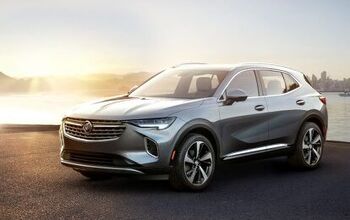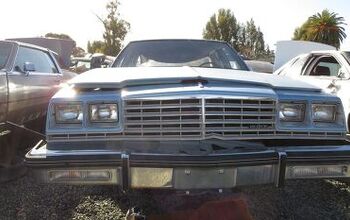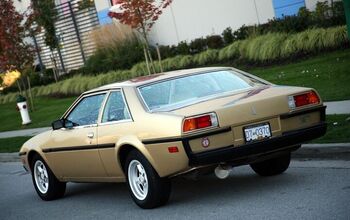It's Buick Again!
As yesterday’s sales graph proves, this is not the greatest time to be re-launching an entry-luxury brand. With Kias and Fords offering the kind of tech gadgets once found only in the upper echelons of true luxury brands, and with well-regarded import luxury marques moving into the front-drive, mass-market, the so-called “premium” brands are finding themselves caught in the middle and losing sales. But in spite of these damning dynamics, GM is moving to overhaul its entry-luxe Buick brand at top speed. Why? Because it can…
Ask Buick’s paid representatives when the much-maligned brand began its turnaround, and they’ll point to the 2007 launch of the Buick Enclave. And sure, the Lambda-platform crossover helped slow Buick’s precipitous decline into “don’t trust anyone under 70” status, but the brand didn’t truly start reversing its terminal sales (and demography) momentum until the Buick LaCrosse became a fixture on showroom floors. Through the first four months of this year, the LaCrosse has already sold just under half the volume it sold in all of 2009 put together.
And no wonder: though not without its flaws, the LaCrosse is a capable mid-to-full-size car, with distinctive Buick cues like the “Sweep-Spear” character line. It manages to look more thoroughly modern than any other recent Buick, while still looking unmistakeably “American” (despite having been styled in Shanghai). Considering the dearth of modern-era inspiration for a contemporary Buick flagship, this is no small accomplishment, and it makes the LaCrosse the natural starting point for a rebirth of the brand.
Apparently though, this is not to be. Whereas the LaCrosse development team took global GM components and created a unique body that captures Buick’s traditional, professional-class values (now alive and well only in China, it seems), the plan going forward is shaping up to be far less sophisticated. With the new Regal, we are seeing the first example of what appears to be Buick’s new strategy: rebadging Opels.
With the bad-old days of badge engineering finally drawing to a close (don’t let the door hit you on the way out, Mercury), it’s being replaced with a new paradigm: global badge-engineering. Fiat-Chrysler is doing this with its Lancia and Chrysler brands, cherry-picking the best from both lineups, and selling the resulting recombination as Lancias in Europe, and Chryslers elsewhere. At GM, the practice centers on leveraging the high-quality Opel products that would otherwise remain trapped in Europe’s brutally competitive and contracting market.
But how will the decision to base Buick’s new products on rebadged Opels affect the Buick brand? At the Regal launch last week, Buick’s PR folks seemed unconcerned with this question. “The plan was always to bring this car to America,” said GM’s midsized and full-size sedan supremo Jim Federico (also VLE for Opel Insignia/Buick Regal). What’s changed is that the Saturn brand, which was going to be Opel’s American-market vessel, is now defunct. Having developed a fresh lineup for Opel, GM had to sell them as something in the US. Too good for Chevrolet (“Excellence For Everyone” tagline notwithstanding) and incompatible with Cadillac’s Art and Science styling, the only way to bring Opels stateside without major restyling was as Buicks.
And though this “market-engineering” approach is all-too reminiscent of GM’s poor past practices, the Buick strategy is surprisingly pragmatic. Instead of starting with a brand image (which, in Buick’s case was badly damaged anyway) and adapting existing technical underpinnings to it, GM is bringing high-quality European products to the US market and letting the Buick brand fall where it may. The quality of these products, say Buick’s reps, will define the Buick brand going forward, instead of the other way around.
The other side of this equation is the death of the Pontiac brand. Without Pontiac’s volume, former Buick-Pontiac GMC dealers (now just Buick-GMC stores) need something other than trucks, crossovers and mid-sized sedans to stay healthy. Buick must expand its offerings into the untested waters of the compact (C-segment) sedan and crossover segments in order to drive business to Buick-GMC showrooms and hedge against another possible gas-price spike that might otherwise scuttle the two-brand channel. Again, Opel is the obvious source of these products, offering already-developed models like the compact Astra and the subcompact Meriva MPV.
Thanks to Buick’s new emphasis on the Chinese market, we already know what comes next: a Buickified Astra sedan has already been caught on camera looking a lot like a half-sized Regal. Less of a pure Opel re-badge than the Regal, this new Jetta/Civic competitor still maintains the brand’s new Opel-bred stylistic subtlety without the sweep-spear and ventiports that make the LaCrosse so obviously a Buick. A Regal wagon is also being talked about, but with Federico telling C&D that this unpopular bodystyle would also offer diesel engines and all-wheel drive, we’re going to take the rumor with several grains of salt. Still, these vehicles confirm the momentum towards making Buick a vessel for lightly-modified Opels.
The only confirmed Buick product that bears much speculating on then, is the compact/subcompact MPV that will be the final piece of a 2013 Buick lineup of which the Regal will be the oldest product (the Enclave and LaCrosse will apparently have been refreshed by then). Referred to in-house as the “baby Enclave,” this MPV will be built alongside the Aveo at Orion Township, strongly hinting at Gamma II platform underpinnings (Buick reps say it will be “either Gamma or Delta”). Given that Buick is otherwise being revived without investing in materially new products, the picture looks clear: this MPV will be an Opel Meriva.
But will this Euro-confection retain the suicide rear doors that will surely satisfy America’s constant craving for novelty? And just as importantly, will it feature styling cues from that other another spot-on Chinese interpretation of modern Buick-ness, the Buick Business Concept? One high-up but new-to-the-job Buick exec I spoke to did not even seem to be familiar with the Business Concept. With the Business’ styling influencing the larger next-gen, Chinese-market-only GL8 minivan, and with Buick’s 2013 lineup otherwise being made up of lightly-retouched Opels, the signs seem to be pointing towards a relatively mild restyle of the Meriva.
There are plenty of very rational arguments for making Opel and Buick interchangeable between markets, the way Chrysler and Lancia will be. If you accept the reasonable premise that Opel’s products are neither Cadillacs nor Chevrolets, then the logical way to build their global volume is to market them as Buicks in the US and China (surely all reasonable people agree that GM needs another US-market brand, Opel in particular, like it needs a hole in the head). The real issue then is how distinctive GM will make the Buick versions compared to their Opel predecessors, the answer to which appears to be not much at all. And there are two reasonable arguments for this: first, that Opel’s design is subtly classy enough to embody a new Buick aesthetic, and second that the money GM might have spent differentiating Buicks will probably be spent rescuing Opel.
In other words, rather than completely re-thinking the traditional approach to entry-luxury branding, GM is simply playing the same old rebadging game across global markets instead of within a single market. That the new Buicks are simply rebadged mass-market Euro-cars is not likely to occur to many buyers, means there’s none of the traditional rebadge strategy downside. For Buick, anyway. The problem with the strategy is that Ford is practicing the exact same strategy, but with its mass-market Blue Oval brand. Rather than bringing its latest European products stateside to revive its nosediving Mercury entry-luxe brand, Ford is using its Fiesta, Focus, Kuga and C-Max to burnish its Ford brand to a shiny finish and (apparently) letting Mercury die alone. Instead of taking on Acura, Lexus and company, Buick could just as easily find itself battling with the mass-market Ford brand for customer consideration. Especially if it falls into the trap of believing that the Opel look is “Buick enough” and that new Buicks don’t need at least some kind of heritage branding element.
Of course, the new Buick-as-Opel strategy is a lot smarter than GM’s immediate post-bankruptcy plan to sell Opel and rebadge Saturns like the Vue for Buick. Once Ed Whitacre decided keeping Opel made more sense than keeping Fritz Henderson, there was no going back from the Opelification of Buick. But Ford’s apparent decision to jettison Mercury in favor of a two-brand strategy that strengthens its mass-market Ford brand seems to point out that, like Henderson, Buick might have been better left behind. Don’t get me wrong: Buick’s current strategy will absolutely strengthen the brand in the short-term (and relatively inexpensively to boot), but over the long haul it will also severely limit Chevrolet’s ability to keep up with Ford’s Euro-premium makeover. In a world of Hyundai-branded luxury cars, this will be a bad situation for GM’s most important brand to find itself in.
So, what’s the answer? As GM’s experience with brands and platforms teaches, differentiation is everything. Though the current batch of Opels are, by all acoounts, attractive, high-quality vehicles, they’re also mass-market European vehicles designed around a brand that means nothing in the US. With entry-luxury brands under assault in the US, GM has to look to the emotional power of a MINI brand to understand how to make Buick fundamentally strong enough to thrive even as Chevrolet steps up its game to keep up with Ford. Clearly the globally underleveraged Opel vehicles are the place to start, but LaCrosse, not Regal is the model to follow.
More by Edward Niedermeyer
Latest Car Reviews
Read moreLatest Product Reviews
Read moreRecent Comments
- El scotto They should be supping with a very, very long spoon.
- El scotto [list=1][*]Please make an EV that's not butt-ugly. Not Jaguar gorgeous but Buick handsome will do.[/*][*] For all the golf cart dudes: A Tesla S in Plaid mode will be the fastest ride you'll ever take.[/*][*]We have actual EV owners posting on here. Just calmly stated facts and real world experience. This always seems to bring out those who would argue math.[/*][/list=1]For some people an EV will never do, too far out in the country, taking trips where an EV will need recharged, etc. If you own a home and can charge overnight an EV makes perfect sense. You're refueling while you're sleeping.My condo association is allowing owners to install chargers. You have to pay all of the owners of the parking spaces the new electric service will cross. Suggested fee is 100$ and the one getting a charger pays all the legal and filing fees. I held out for a bottle of 30 year old single malt.Perhaps high end apartments will feature reserved parking spaces with chargers in the future. Until then non home owners are relying on public charge and one of my neighbors is in IT and he charges at work. It's call a perk.I don't see company owned delivery vehicles that are EV's. The USPS and the smiley boxes should be the 1st to do this. Nor are any of our mega car dealerships doing this and but of course advertising this fact.I think a great many of the EV haters haven't came to the self-actualization that no one really cares what you drive. I can respect and appreciate what you drive but if I was pushed to answer, no I really don't care what you drive. Before everyone goes into umbrage over my last sentence, I still like cars. Especially yours.I have heated tiles in my bathroom and my kitchen. The two places you're most likely to be barefoot. An EV may fall into to the one less thing to mess with for many people.Macallan for those who were wondering.
- EBFlex The way things look in the next 5-10 years no. There are no breakthroughs in battery technology coming, the charging infrastructure is essentially nonexistent, and the price of entry is still way too high.As soon as an EV can meet the bar set by ICE in range, refueling times, and price it will take off.
- Jalop1991 Way to bury the lead. "Toyota to offer two EVs in the states"!
- Jalop1991 I'm sorry, Dave. I'm afraid I can't do that.


































Comments
Join the conversation
The Cruze arriving with a twist beam rear axle is a huge blunder.
I currently drive a GM, a 2008 Chevy Impala which is consistantly bashed as one of the worst piles of shit ever devised on this site so the Buick hatred doesn't surprise me. I am not however a major GM fanboy or a fanboy of any particular make. If the car is reliable, suites my needs, is recommended by friends, is made in an award winning factory, has the room and comfort I need and has a good compromise between power and mileage then that is what I will drive. The Impala 2LT 3900 V6 I currently drive has exceeded my expectations in many areas expect lacking a few features like a telescoping wheel and some dash material is hard plastic. Still it has 64k miles now and has not been in the shop for anything other than oil changes and tires so far. If this car continues to give me such excellent service and remains tight and rattle free then I will happily but another.